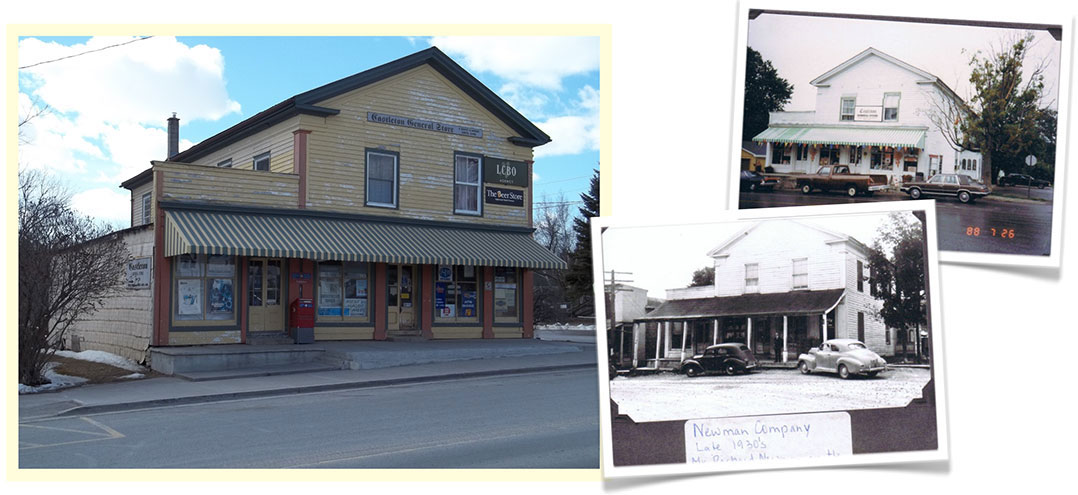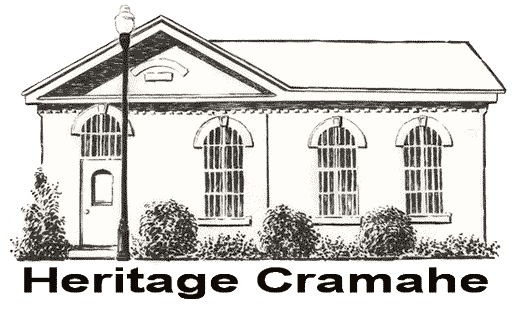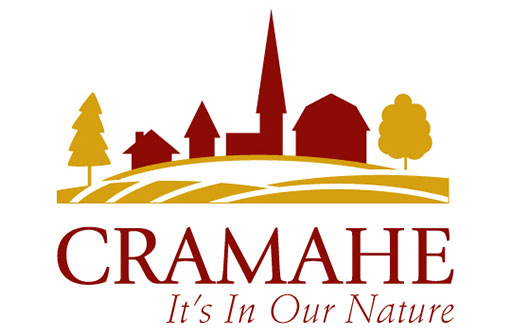Castleton General Store, 1768 Percy Street, Castleton
(1850)
Roll No. 1411-011-050-02800 – Cramahe Township Ontario

Rural General Store
There is a G.W. Pennock, general merchant, listed under Castleton in the 1865 Gazetteer and General Business Directory of Northumberland and Durham.
Richard S. Newman, a grocer from Morganston, sold his business in 1891 to take over the General Store in Castleton. The Newman Company acquired the property and it remained in family hands until 1976, at which time Mr. Newman’s granddaughter Marjorie Dingwall and her husband David, sold it.
Throughout its history, up to that time, one could buy dry goods, hardware, clothing, paint, wallpaper, toys, penny candy, sewing implements and fabric, fence wire, china and glassware. The first telephone office was opened at the back of the store.
After 1976, the character of the General Store remained in its original state, but the goods offered evolved to that of a “convenience” store and much of its variety of stock was reduced to basics like food, movies and later, an outlet of the LCBO.
The building is wooden with narrow clapboard siding. The old wooden floors in the interior are worn down by generations of customers lending an aura of history to the place in spite of its current, contemporary products.
Many of the old store fixtures and early Castleton photos are on display and residents flock to the store for the tasty ice cream cones.
The Castleton General Store serves many purposes, not the least of which is a meeting place for the citizens of the small village in which it does business.
History or Associative Value
The Castleton General store may have been built as early as 1850. It has carried on business for 165 years to date. There is no reason to disbelieve it will carry on for another century!
Additional Historical and Genealogical Information
Cramahe Township, Concession 7, Lot 34 Castleton Lot 98 Castleton General Store
When Cramahe Township was first surveyed in the 1790’s a seventh of its land was set aside for crown reserves and another seventh was set aside for clergy reserves. These reserves were rented to tenant farmers. The revenues from the crown reserves went to the government. The revenues from the clergy reserves originally went only to the Church of England (Anglican), but after 1824 the Church of Scotland (Presbyterian) was granted a share, and by the 1840s all of the major protestant denominations were included (except the Baptists, who refused to participate). The clergy reserve system came to an end in 1854, when all revenues reverted to the government.
The first official owner of the land on which Castleton Lot 97 now sits was the Canada Company. The Canada Company was a private British corporation incorporated in 1826 to aid in the development and colonization of Upper Canada with an emphasis on the Crown and Clergy Reserves. Among the lands acquired by the Canada Company were the southern 100 acres of Concession 7, Lot 34, Cramahe Township, where the western part of Castleton now sits. The Company was granted this land by the Crown on 28 May 1830.
By 1834 the 100 acres were in the hands of Joseph Abbott Keeler (1788-1855). No record has been seen of his acquiring them from the Canada Company, although there is an 1881 document certifying that the transfer had indeed been made.
The Keelers were involved in the history of the area long before they were official owners of this property, having built a mill in Castleton as early as 1806 (How Firm a Foundation, Argyis 2000). During his years of ownership Keeler sold of bits and pieces of his land. On 13 January 1854 he sold the northern part of Lot 98 to lumberman Henry Blakley (1817-?), who immediately (14 January 1854) sold it to Elnathan Alger (1814-1868), a Cramahe farmer.
Alger sold his part of Lot 98 to Clarissa Emily Pennock (1824-1904, maiden name unknown) on 6 May 1868. Clarissa was the wife of John Coleman Pennock (1822-1884), a Castleton merchant as well as postmaster and township clerk. Interestingly, Henry Blakley’s son-in-law Hudson Price Gould (1835-1914) would take over those offices after Pennock left them. The Pennocks had three children: James Elgin (1847-1916), Lillian Maria (1857-1950), and George Edward (1864-1957).
John Pennock died in 1884 and Clarissa remarried, this time to Thomas Crawley (1828-1911), another merchant. She and Crawley sold the northern part of Lot 98 to William John Newman (1840-1904) on 26 September 1890.
Newman is listed in records as a storekeeper at least as far back as 1871. He was married to Maria Mahitabel Cole (1849-1920) and had six children: William S. (ca. 1868-?), Richard Sidney (1869-?), John Wesley (1875-?), Joseph Henry (1879-?), James Orloff Roy (1885-1963), and Esther Elizabeth (1890-1927). When he died in 1904, the property went to his sons Richard and John (6 November 1904). On 5 January 1921 John transferred his interest in the property to Richard.
How Firm a Foundation (Argyris 2000) indicates that the Newman General Store opened in 1891, which fits well with the purchase of the property by William Newman in late 1890. Previous owners John Pennock and Thomas Crawley were also merchants, so one has to wonder if the general store predates William Newman’s purchase. Of course “merchant” doesn’t necessarily mean “general store proprietor”.
It is also interesting to note that land office records from 1858 and 1882 refer to a township (or town) hall on Lot 98, on or near the site of the general store. The 1858 record refers to it as “the township hall now erected on said village lot”, suggesting that at that time it was of relatively recent construction. The purchase of the general store site by William Newman almost, but not quite, jibes with the construction of a new township hall 35 m to the north on Castleton Lot 25 in 1892.





